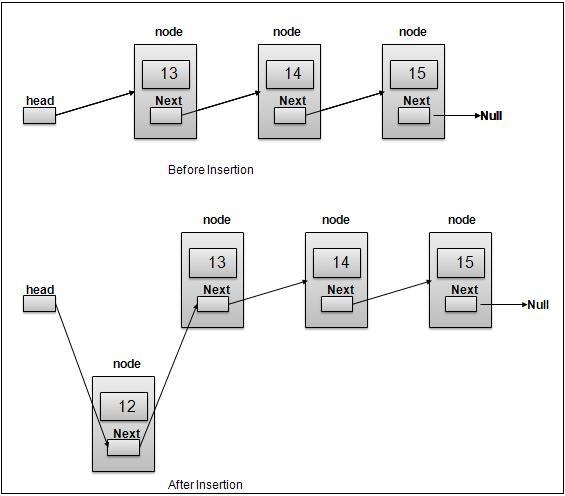使用 JavaScript 將元素插入雙向連結串列
我們需要建立一個函式 insert(data, position),該函式在連結串列的給定位置插入資料。我們將執行以下步驟:
- 建立一個新的節點
- 檢查列表是否為空。如果是,則將節點新增到頭部和尾部並返回。
- 如果不是,我們將使用 currElem 迭代到我們想要插入的位置。我們透過使 currElem 等於 currElem.next 來迭代連結串列。
現在,我們將以以下方式更改連結:
- 使新節點指向列表中的下一個節點
- 使下一個節點的上一個指向新節點
- 使我們的節點指向前一個節點
- 使前一個節點的下一個指向新節點
最後,我們斷開 currElem 與列表其餘部分的連結,並使其指向我們建立的節點。現在,該節點位於列表中給定位置。
這是一個相同的示例:

現在讓我們看看我們將如何實現它:
示例
insert(data, position = this.length) {
let node = new this.Node(data);
this.length++;
// List is currently empty
if (this.head === null) {
this.head = node;
this.tail = node;
return this.head;
}
// Insertion at head
if (position == 0) {
node.prev = null;
node.next = this.head;
this.head.prev = node;
this.head = node;
return this.head;
}
let iter = 1;
let currNode = this.head;
while (currNode.next != null && iter < position) {
currNode = currNode.next;
iter++;
}
// Make new node point to next node in list
node.next = currNode.next;
// Make next node's previous point to new node
if (currNode.next != null) {
currNode.next.prev = node;
}
// Make our node point to previous node
node.prev = currNode;
// Make previous node's next point to new node
currNode.next = node;
// check if inserted element was at the tail, if yes then make tail point to it
if (this.tail.next != null) {
this.tail = this.tail.next;
}
return node;
}請注意,我們已將位置指定為最後一個元素。這是因為,如果您不提供位置,則預設情況下它將插入到末尾。
您可以使用以下方法進行測試:
示例
let list = new LinkedList(); list.insert(10); list.insert(20); list.insert(30); list.insert(15, 2); list.display();
輸出
這將給出以下輸出:
10 <-> 30 <-> 15 <-> 20 <->
正如我們所看到的,所有元素都按我們預期的順序排列。我們嘗試在 2 之後的位置插入 15。

廣告

 資料結構
資料結構 網路
網路 關係型資料庫管理系統
關係型資料庫管理系統 作業系統
作業系統 Java
Java iOS
iOS HTML
HTML CSS
CSS Android
Android Python
Python C 程式設計
C 程式設計 C++
C++ C#
C# MongoDB
MongoDB MySQL
MySQL Javascript
Javascript PHP
PHP